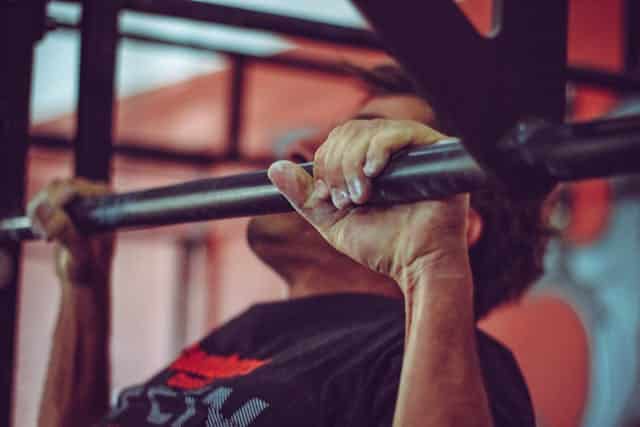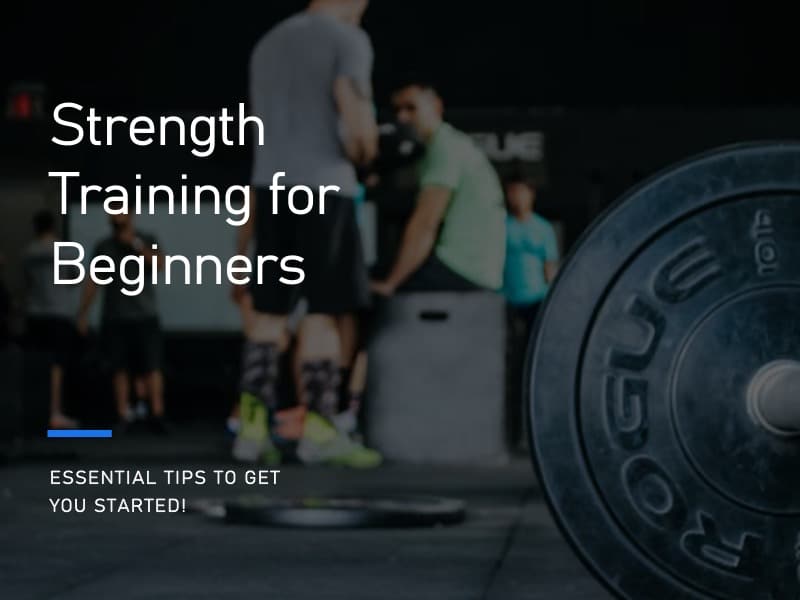Strength Training for Beginners: Tips That Actually Work!
Strength training for beginners or anyone new to fitness is one of the most effective ways to develop a healthier, stronger, and more resilient body.
Whether your goal is to improve muscle tone, increase bone density, or boost long-term performance, starting with the right approach sets the foundation for lasting progress.
Studies consistently demonstrate that resistance training increases strength, promotes metabolic health, and reduces the risk of chronic disease (Fragala et al., 2019).
These benefits make it a cornerstone of fitness, even for people who are just starting out.
Still, many beginners feel unsure about where to begin, and questions about free weights versus machines, which exercises are most important, or how to avoid injury are all common.
By focusing on proper technique, simple programming, and steady progress, you can develop confidence and consistency in the gym.
As a professional athlete with experience working with a diverse range of athletes and trainees, this guide will walk you through effective strategies and practical strength training tips to help you master the basics of strength training for beginners.
What is Strength Training for Beginners?

Strength training for beginners refers to structured exercise programs designed to help newcomers build strength, improve muscle tone, and develop safe movement patterns.
At its core, strength training, also known as resistance training, involves using resistance (such as free weights, resistance bands, or even your own body weight) to challenge your muscles and stimulate growth.
For beginners, the main goal is not to lift the heaviest weights possible but to learn proper form, develop consistency, and create a foundation for long-term progress.
Starting with simple compound movements, such as squats, deadlifts, and presses, allows you to train multiple muscle groups simultaneously while learning to control your body under load.
This approach helps reduce the risk of injury, promotes balanced development, and builds confidence in the gym.
Over time, beginners can gradually increase the weight, vary their exercises, and follow progressive training programs tailored to their individual goals.
How to Start Strength Training for Beginners

Focus on the Big 4
Focusing on compound exercises, such as the “big four” of the deadlift, squat, shoulder press, and bench press, is particularly beneficial for strength training beginners.
These compound exercises involve multiple joint movements and engage multiple muscle groups at once, making them highly effective for building overall strength and muscle mass.
In contrast, isolation exercises, such as bicep curls or leg extensions, only target a single muscle group and may not be as effective for building overall strength.
By making compound exercises the foundation of your strength training program, you can more efficiently and effectively target multiple muscle groups and build a solid foundation of strength.
While the row and chin-up are good for strength training, they should be secondary to the big four compound exercises.
Start With Free Weights, Not Machines
Free weights vs machines is a common debate in the strength training world, but I firmly believe free weights are the better option.
Free weights, such as barbells and dumbbells, are essential for strength training beginners.
These types of weights offer several benefits compared to workout machines, which often have a more limited range of motion and may not provide as much of a challenge for the muscles.
Barbells, in particular, are very versatile and can perform a wide range of exercises, including the big four of the deadlift, squat, shoulder press, and bench press.
Barbells from Ascend are a great option if you are considering adding some strength training equipment to a home gym.
When starting out, it’s a good idea to use relatively light weights and focus on proper form to ensure that you’re using good technique and minimizing the risk of injury.
As you progress in your training, you can gradually increase the weight to challenge your muscles and continue to make progress.
Using free weights, you can more effectively target multiple muscle groups and build overall strength and muscle mass.
Keep Your Workouts Simple
As a beginner, it’s important to focus on building a strong foundation of strength and technique before attempting more advanced exercises or workouts.
One way to do this is by keeping your workouts simple and focusing on the basics.
This means avoiding the temptation to do too many exercises at once and focusing on a few key movements that target multiple muscle groups.
Doing this can ensure that you’re using good form and technique and avoid the risk of injury.
In addition to keeping your workouts simple, paying attention to the tempo, or speed of movement, that you use is important. Using a consistent tempo can help you maintain control of the weight and better engage the targeted muscle groups.
This is especially important for beginners, who may be more prone to losing control of the weight and risking injury.
By focusing on good form, technique, and tempo, you can set the stage for more advanced workouts as you progress in your strength training journey.
Track Your Workouts
It’s important to track your progress by keeping a log of your workouts, including the exercises, sets, reps, and weights used.
Tracking your workouts in a log is an important aspect of strength training because it helps you monitor your progress and identify areas for improvement, while also helping prevent weightlifting plateaus and burnout.
By keeping track of the exercises, sets, reps, and weights used in each workout, you can see how you progress over time and adjust your training accordingly.
This is especially useful for beginners who may not clearly understand their baseline strength levels and need to track their progress more closely.
In addition to helping you monitor your progress, tracking your workouts in a log can provide several other benefits.
For example, it can help you set and achieve specific training goals, such as increasing the weight you’re lifting or increasing the number of reps you can do.
Tracking your workouts can also help you identify any weaknesses or imbalances in your muscle development and target those areas with specific exercises.
Overall, tracking your workouts in a log is a valuable tool for anyone looking to improve their strength and athletic performance.
Don’t Overload
It’s important not to overload your workouts by trying to do too much at once.
Stick to a maximum of 4-5 lifts per workout, and keep the session short to avoid overstressing your body and negatively impacting your hormones.
Instead, focus on performing one main lift per workout, along with 2-3 assistance lifts to target specific muscle groups.
By consistently working on your strength training, you can build strong muscles and improve your body composition.
To continue challenging your muscles and making progress, consider rotating through different rep ranges in your workouts and pushing yourself beyond your comfort zone.
As you increase the weight you’re lifting, be sure to do so slowly and consistently, and focus on maintaining good form and technique.
By taking your time and working on your consistency, you can maximize the effectiveness of your strength training and see the best results.
Most Effective Strength Training Exercises for Beginners

When starting out, it’s best to focus on compound lifts and simple bodyweight movements that train multiple muscles at once.
These exercises form the foundation of strength training for beginners, teaching proper mechanics while building strength and confidence.
- Squat: One of the most important lower-body exercises, squats strengthen the quads, hamstrings, and glutes while also improving core stability. Beginners can start with bodyweight squats before progressing to goblet squats or barbell squats.
- Deadlift: Deadlifts target the posterior chain, including the hamstrings, glutes, and lower back. Beginners should start with lighter weights or variations, such as Romanian deadlifts, to learn proper hip-hinge mechanics.
- Bench Press: A staple upper-body exercise, the bench press builds strength in the chest, shoulders, and triceps. Beginners can start with dumbbells before moving to a barbell for added stability and control.
- Overhead Press: Also called the shoulder press, this movement trains the shoulders, triceps, and upper chest while developing pressing strength overhead. Dumbbells often feel more comfortable for beginners than a barbell.
- Row: A key pulling movement, rows strengthen the upper back, lats, and biceps, helping improve posture and balance out pressing exercises. Beginners can use dumbbells or resistance bands.
- Pull-Up or Assisted Pull-Up: This classic bodyweight exercise builds upper body strength, particularly in the back and arms. If pull-ups are too challenging at first, beginners can use bands or machines for assistance.
- Forearm Plank: A simple yet highly effective core exercise, forearm planks build abdominal strength and stability, which are essential for safe and strong lifting. Beginners can start with short holds and gradually increase duration.
- Glute Bridge or Hip Thrust: Glute bridges and hip thrusts are similar yet different exercises that target the glutes and hamstrings, improving hip strength and stability. Beginners can start with bodyweight versions before adding resistance with a barbell or dumbbell.
- Step-Up: Using a bench or box, step-ups train the quads, glutes, and core while improving balance and unilateral strength. Beginners can start with bodyweight before progressing to dumbbells.
- Farmer’s Carry: Holding weights in each hand and walking for distance or time helps develop grip strength, core stability, and full-body conditioning. This functional exercise is excellent for beginners learning to stabilize under load.
Final Thoughts: The Best Strength Training Tips for Beginners

Strength training for beginners doesn’t need to be complicated.
By focusing on compound movements, starting with free weights, and maintaining simple and consistent workouts, you can establish a foundation that supports long-term progress.
Tracking your workouts and avoiding overload will help you stay safe while steadily improving strength and confidence.
The best strength training tips for beginners come down to patience and consistency.
Mastering proper form, gradually increasing weight, and committing to regular training sessions will deliver noticeable results in both strength and overall health.
With the right approach, your first steps in the gym can set the stage for years of sustainable fitness and personal growth.
Read Next: Health Benefits of Weight Training
This website does not provide medical advice. This website site does contain affiliate links, and purchases may earn a commission.
Read my Medical Disclaimer, Review Disclaimer, and Publishing Policies for more details. Use of this site indicates acceptance of these terms.



